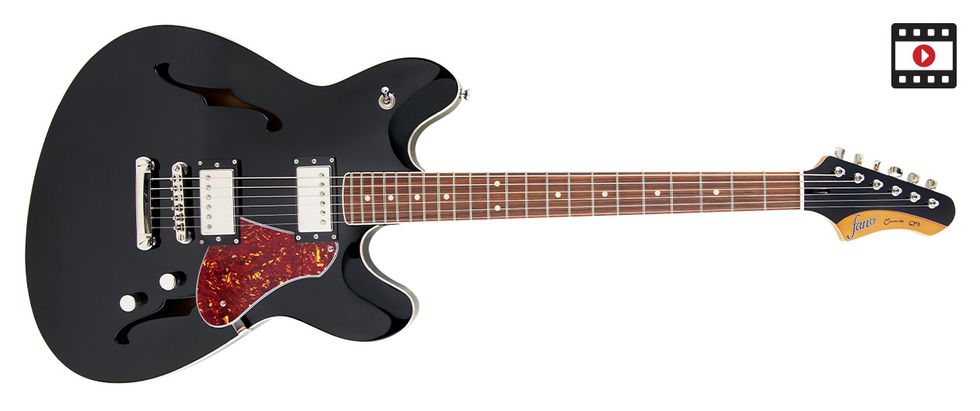RatingsPros:Excellent quality and attention to detail. Suprisingly airy humbuckers. Neck feels great. Compound fretboard radius. Cons: A touch expensive. Two-control layout is limiting. Street: $999 Fano Omnis GF6 fanoguitars.com | Tones: Playability: Build/Design: Value: |
If you ever get the chance to play an original Fender Starcaster, don’t pass on the experience. Not that it’s a common opportunity. Fender didn’t sell many Starcasters, and sightings today are an irregular-to-rare event even in the highest profile vintage shops. But many specimens were great guitars, full of unique sounds and feel. In recent years, the Starcaster’s unusual shape, component parts, and tones became things of interest to boutique builders—including Fano, of course, which released its first version of the up-market Alt De Facto GF6 in 2013. Interest hasn’t abated since. The instrument’s steadily elevated profile has even prompted the release of mass-produced affordable takes on the Starcaster style.
Significantly, Fano’s new China-made Omnis-series GF6 is among the first Starcaster-influenced instruments to bridge the gap between entry level and boutique categories. And while it’s not cheap at just under $1K, the Omnis GF6 delivers many of the ergonomic and aesthetic joys of its inspiration while ironing out eccentricities that could estrange more straight-ahead players.
Staring by Star Glow
It’s not hard to imagine why the original Starcaster’s shape was polarizing. Semi-hollow guitars often appeal to traditionalists, and there was little in the way of tradition to turn the heads or change the minds of prospective ES-335 buyers. The offset waist, for instance, screamed Jazzmaster and Jaguar at a time when Fender’s ’50s designs were back en vogue and their surfy ’60s shapes considered passe. For many players just now basking in the afterglow of popular offset reappraisal, the compound curves, arches, and shifting lines will be a revelation. Fano’s glossy “bull black” shade in particular highlights the complex lines—simultaneously evoking the sweeping fenders of a ’48 Buick Roadmaster and the irreverence of mid-’70s small-batch guitar-craft.
Rather than laminate maple, which is used on most semi-hollow archtops, the Omnis GF6 is fashioned from arched solid alder on top and a flat, solid alder back and sides. At about nine pounds, the Omnis GF6 is pretty hefty, too. The 2-piece maple neck feels like a not-too-chunky Fender ’60s C-shape, and it’s a nice fit for the compound 9.5"-12" radius pao ferro fretboard, which facilitates bends up high and chording among the lower frets. Despite its very non-vintage spec, it manages to feel both fast and vintage-y, and the flatter radius encourages you to take advantage of the contoured heel, which tapers on the treble side to give you easy access all the way to the 22nd fret. Medium-jumbo frets make the guitar feel even more bend happy. Semi-hollows rarely feel so shreddy past the 12th fret.
We’ve grown used to high quality in accessibly priced, import guitars. And even though the Fano’s $999 price tag pushes “affordable” to the limits of its definition for most folks, the build quality remains impressive. The polyurethane finish is smooth and flawless around the f-holes. The neck pocket is uniform and tight. The guitar is also very tuning stable.
Stylistic Omnivore
Starcasters were distinguished by their Wide Range pickups, which famously (or infamously, depending on your perspective) mated the sum of the chiming qualities of a Telecaster pickup with the brawn of a Gibson humbucker. Here, Fano uses what they call a “proprietary” humbucker—presumably based on a PAF.
Fano—or their OEM pickup provider—did a lot of things right with these pickups. They’re not plagued by the muddiness that ruins most affordable PAF-style humbuckers. They’re airy, not too hot, fairly dynamic and remarkably well balanced between high-end sparkle and bass ballast—making them able to stand in for a Telecaster, a Rickenbacker, or a Gretsch in a recorded mix if you’re clever and attentive to your volume, tone, and approach. Not all humbuckers are equally suited for folk-rock jangle and smoky jazz-blues duties, but the Fano’s pickups—assisted no doubt by the body’s zingy and outstanding acoustic resonance—can span that range.
It’s a shame that good Wide Range replicas are so expensive, because I would love to hear a set in this guitar, which otherwise flirts so unabashedly with Starcaster style. With its well-balanced pickups, the GF6 tends to sound like a more open, less burly Gibson ES-335—which is no bad thing. But it would be awesome to experience such a different-looking guitar with an equally unusual pickup pairing. And while you wouldn’t be able to fit a set of full-size Wide Range pickups without re-routing the body, there is no shortage of options that can fit here if your inner deviant wins the day. It would be neat to see Fano offer such an option.
The Verdict
There’s a lot of the original Starcaster’s rebel spirit in the GF6. Sticklers may lament the smaller pickguard and headstock, the lack of Wide-Range pickups, or omission of the 5-knob control array with master volume that appeared on the original. But the GF6 is a great instrument on its own merits. If you’re in the market for a 335-sounding axe that breaks from style dogma, you’re in business with the GF6. And if you’ve lusted for a Starcaster-style axe and can hang with deviation from the Wide Range humbucker sound and style, you, too, are likely to reap many benefits, sonic and otherwise, from your investment.
Check Out the Video:








![Rig Rundown: Russian Circles’ Mike Sullivan [2025]](https://www.premierguitar.com/media-library/youtube.jpg?id=62303631&width=1245&height=700&quality=70&coordinates=0%2C0%2C0%2C0)

















